
Installation @ China Basin Center, S.F. (Above)
Visitors and the artist (below) having fun with neuro-themed art.
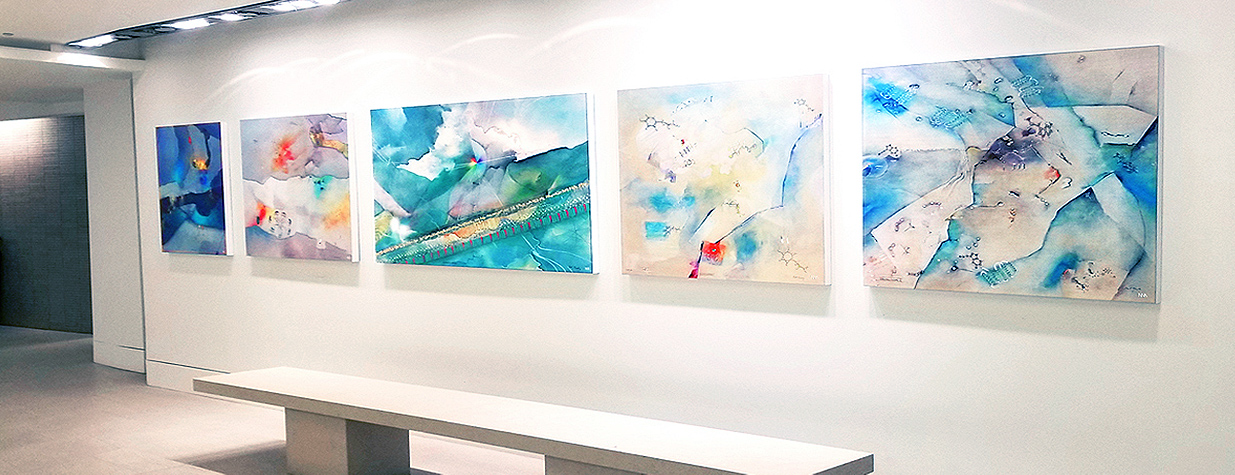

(Below) Avalanche Biotech

Installation @ Avalanche Biotechnology a clinical-stage biotech company focused on gene therapies.
More @ CODAworx
Glutamate Receptors
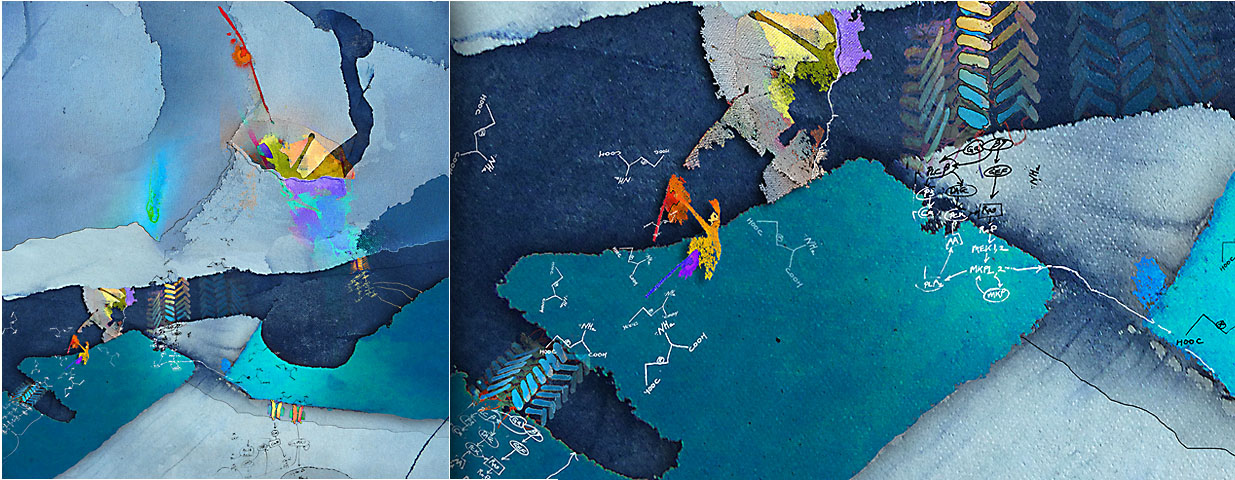
Glutamate Koan 40" x 32" work on paper
Detail
Video Clip :: detail of layered Plexiglas + video version of Glutamate Koan.
Neurotransmitter action can be excitatory or inhibitory... often both depending on the pathway involved. Glutamate is exceptionally prevalent in our bodies, especially in the cortex, where it is a primary excitatory neurotransmitter. A number of receptor types transmit glutamate signaling to the interior of a neuron. One class is the familiar G-protein coupled receptor (more below), and the others often involve ion channels. Both are shown in this painting Glutamate Koan.
Serotonin and Dopamine Receptors
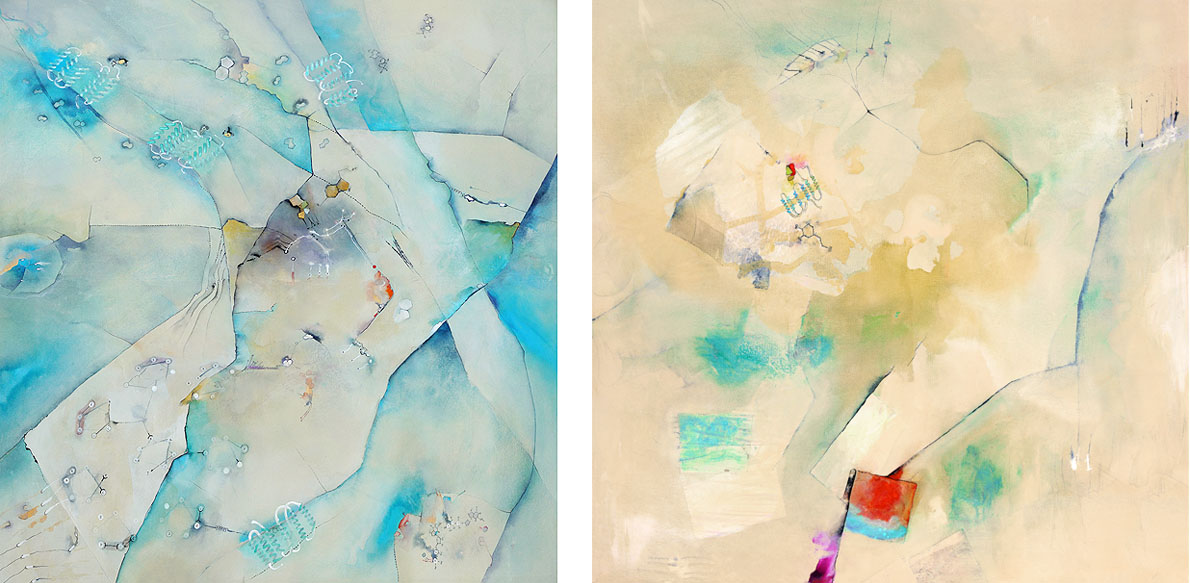
Serotonin 5HT Receptor 52" x 52" acrylic washes and ink.
Dopamine D2 Receptor 52" x 52" acrylic washes and ink.
One class of receptors for many neurotransmitters, including dopamine and serotonin, are the G protein-coupled receptors. They are characterized by a helical protein molecule that winds back and forth through the neuronal cell membrane seven times. The helix can be seen in both paintings above. The red and turquoise square thing is not part of any cell. It's from outer space.
G protein-coupled receptors (GPCR) sense molecules outside the cell and activate inside signal transduction pathways and, ultimately, cellular responses. GPCRs have been linked to many normal and disease-related biological conditions. In fact, up to 60 percent of modern medicinal drugs affect this class of receptor target. *
Mammalian Retina
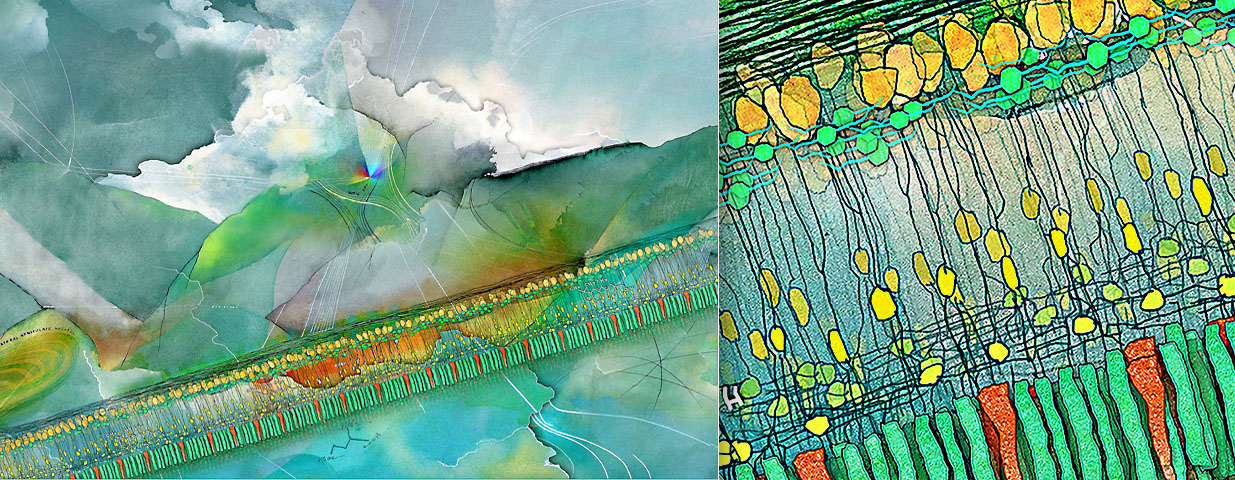
Mammalian Retina 52" x 82" digital print and mixed media
Detail
Our retinas are astoundingly complex. They accomplish much signal processing well before any image information passes to our brain's visual cortex (edge detection and movement, as examples). The order of the neuron layers seems to be at odds with intuition. Light, when it finally reaches the retina after first entering through our pupil, must pass through multiple layers of neurons before ever striking the retinal target - the rod (green) and cone (orange) photo receptors that make up the last layer. There are explanations for this arrangement, nonetheless, it's an evolutionary curiosity.
GABA
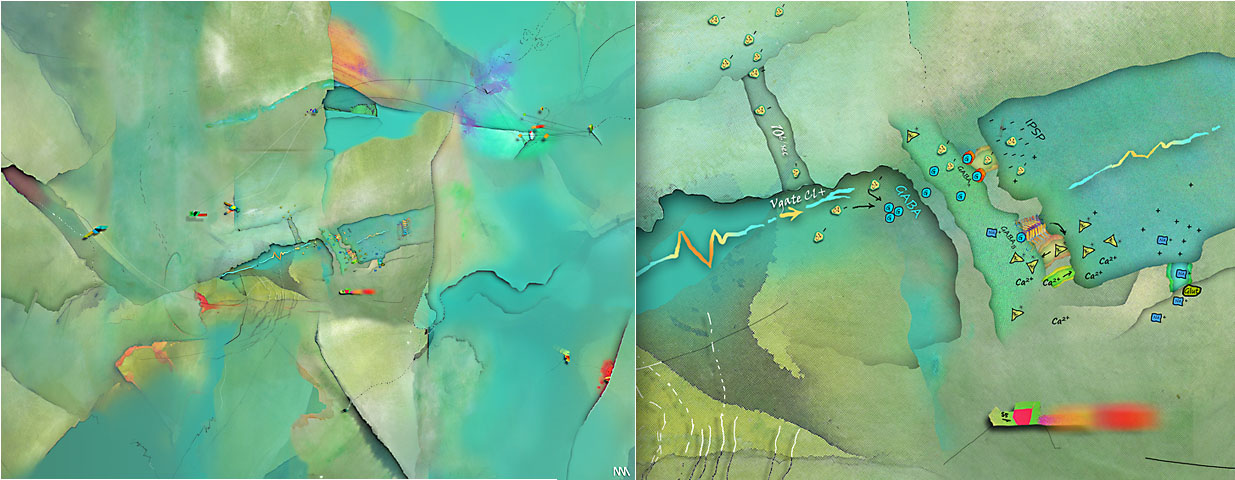
GABA Bottom of a Dream 44" x 62" digital print and mixed media
Detail
GABA is a "stop" neurotransmitter. It's action is primarily inhibitory. For example, it can help keep us from feeling overstimulated. Drugs that calm us down, like the benzodiazapines (e.g. Valium & Librium), bind to and activate GABA receptors. GABA Dreamtime shows the primary GABA receptors in action. Below is the Manual Digital group exhibition at Levy Art + Architecture's gallery – space.151. On the far wall of the gallery are three limited edition prints: Serotonin, GABA Bottom of a Dream, and Alpha Helix which shows the beautiful helical structure of the G-protein-coupled receptors.

GABA Bottom of a Dream 24" x 24" multi-layered polycarb with LED illumination
Manual Digital exhibition: Serotonin, GABA Bottom of a Dream, and the GPCR's Alpha Helix
The Four Dopamine Pathways and Alpha Helix Structure of the G-Protein-Coupled Receptor

Dopamine Pathways 30" x 34" digital print + mixed media
Detail
Alpha Helix 44" x 40" digital print + mixed media
Detail
Nerve Impulse in Action
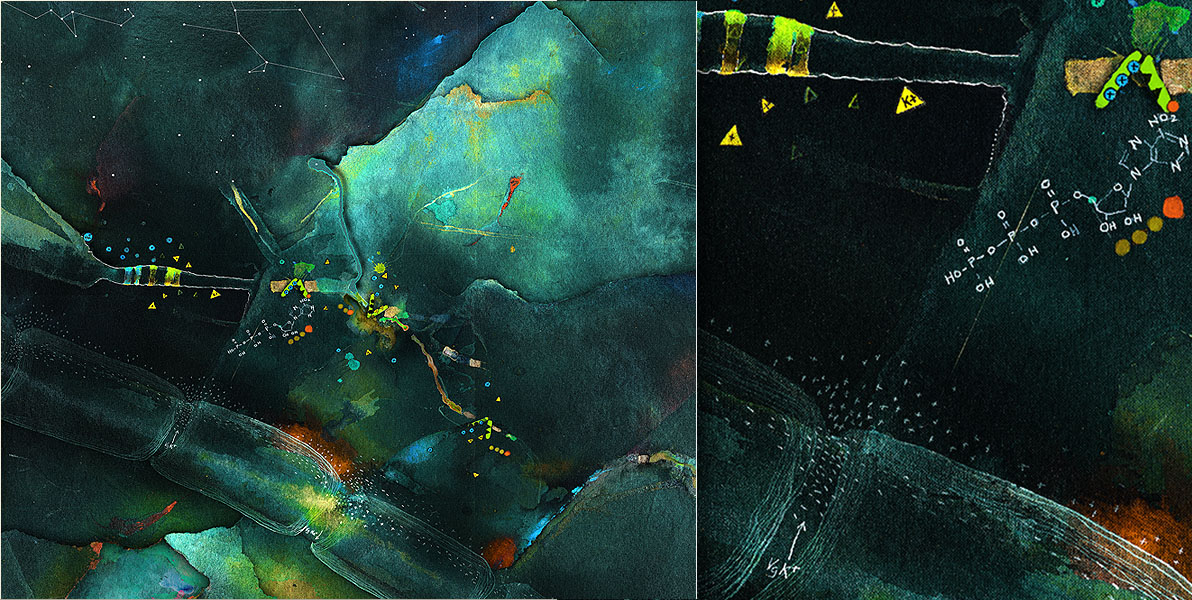
At Least They Have Potential 30" x 26" acrylic washes and ink
Detail
Axons carry nerve impulses, action potentials, to a down-stream (mostly) synapse where neurotransmitters continue the signal passing across the synapse to the following neuron. This painting shows an action potential (the glowy area between two long 'beaded' segments) traveling down an axon. The beads on the string are insulating myelin. The node between them is a veritable Rube Goldberg machine of ion pumps and channels all working together to keep the impulse on it's way, or sometimes inhibit it. Representations of these 'moving parts' can be seen in the detail to the right.
Optogenetics
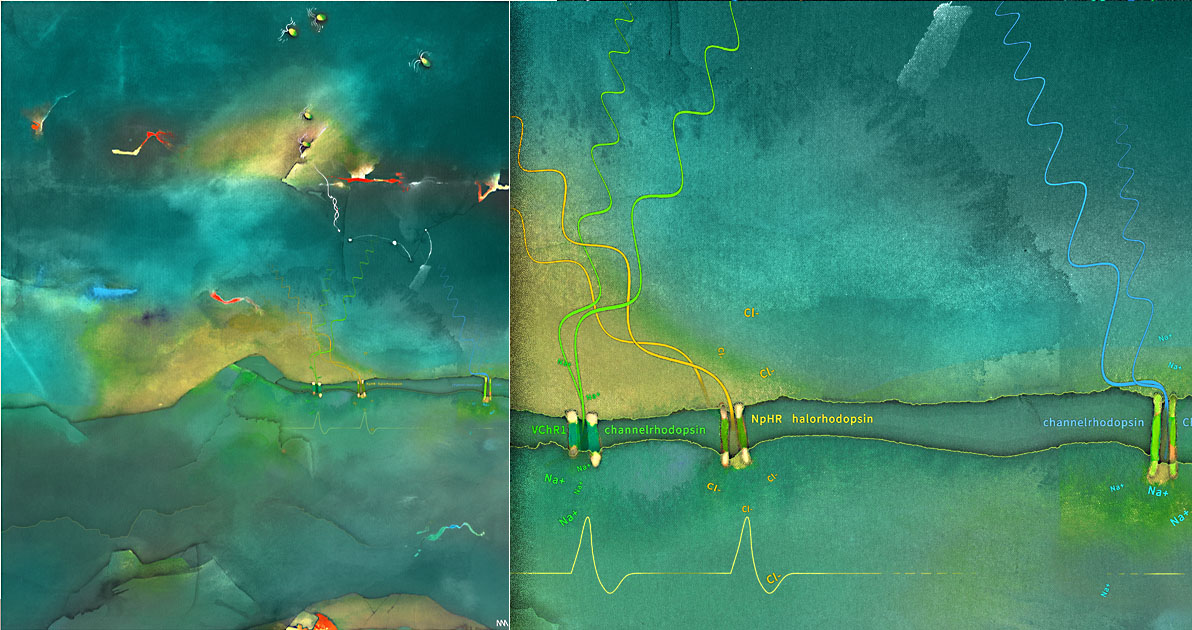
Optogenetics 34" x 44" limited edition print
Detail
Amazing. We're made out of Legos! Take a gene that carries instructions to build a light-sensitive channel in the cell wall of a simple green algae, insert it into a mammalian neuron's DNA and voila, that neuron can now be switch on, or off, with colored light (shown schematically in the work above). The gene can be delivered to neurons in a highly specified manner, so only those cell types one wants to study are affected. This technology makes possible study of select neural networks and is far more useful than the practice of using a tiny electric probe to deliver a small current to a well defined area, but which 'lights up' all neurons in the neighborhood -- not just those one wants to observe. For more on this fascinating topic, have a look at the work of Stanford University's Karl Deisseroth, M.D., Ph.D. by visiting this informational site Optogenetics .
Acetlycholine
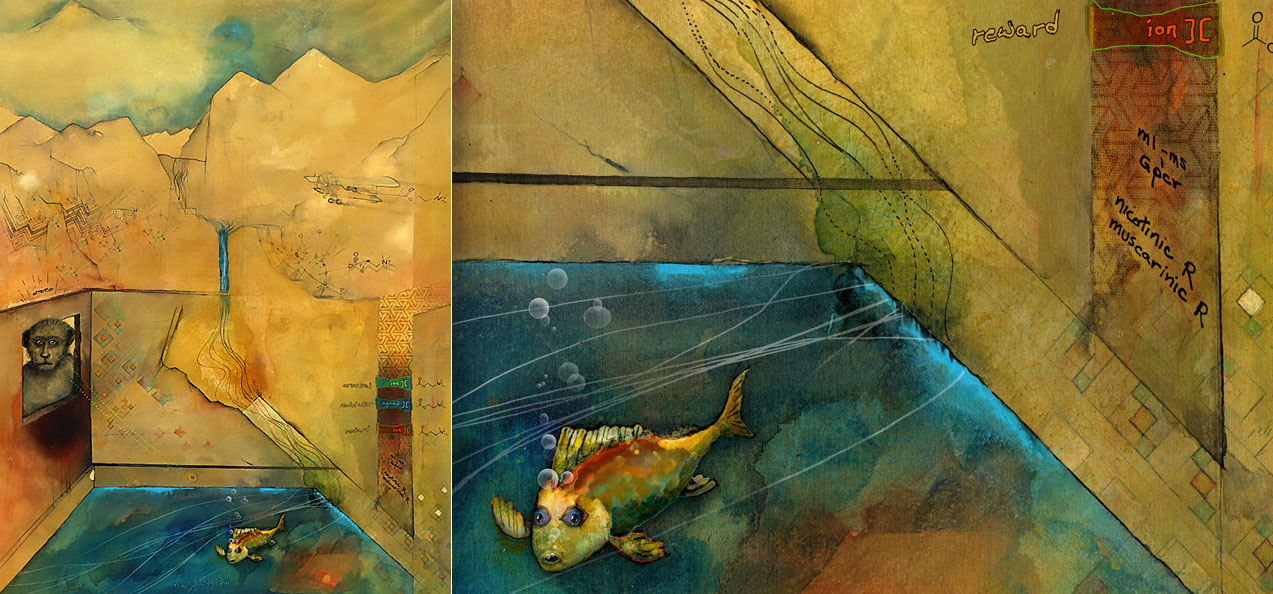
Neuroscientist Concentrating on Fishperson
30" x 40" limited edition print
Detail
Acetylcholine, ACh, is the first neurotransmitter discovered and is the most abundant in our bodies. You wouldn't do very well without it. ACh affects our ability to pay attention, be alert, and form memories. The brain of the hairy neuroscientist in the artwork above is using ACh to help pay attention to the fishperson, and to form a memory about it's uncanny gaze. ACh enhances our neural plasticity and promotes REM sleep. It affects our sensation of pain, our state of arousal, and if it's action is inhibited or blocked by botox, sarin, curare, or hemlock, we won't be long for this earth.
* Abstracted from Wikipedia